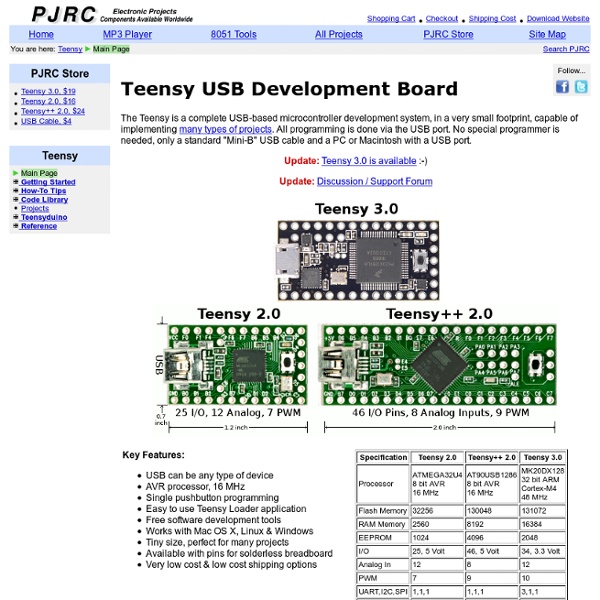Teensy USB Development Board
The Teensy is a complete USB-based microcontroller development system, in a very small footprint, capable of implementing many types of projects. All programming is done via the USB port. No special programmer is needed, only a standard "Mini-B" USB cable and a PC or Macintosh with a USB port. Update: Discussion / Support Forum Teensy 3.1 changes from Teensy 3.0 Teensy Loader Application Software Development Tools WinAVR C compiler. Teensyduino, add-on for Arduino IDE. Simplified USB Examples or Dean Camera's LUFA library. Breadboard Usage The Teensy is available with header pins, for direct no-soldering-required use on a breadboard, which can also be run from the +5 volt from the USB cable. The 128x64 Graphics LCD can be used with Teensy 2.0 and Teensy++ 2.0 and Teensyduino using this GLCD library.
Ethernet Shield for Arduino with Power-over-Ethernet: here at last
After months of plotting and scheming and prototyping and testing and fighting with EAGLE, the first production batch of the Freetronics Ethernet Shield with Power-over-Ethernet support has now landed. Ahh, it's a beautiful thing: As explained on the product page it includes a few improvements to the reference design, such as: Slaving the Wiznet enable line to the SPI select line Improved power filtering for better noise suppression Improvements to reset circuit to reliably reset the Wiznet chip when the Arduino resets Power-over-Ethernet magjack with PoE connections brought out to a header MASSIVE prototyping area! To make it as cheap as possible to power your Arduino via the LAN we've given it the flexibility of supporting either full standards-compliant 802.3af/at PoE, or cheap home-brew PoE using something like our sweet new 4-Channel PoE Midspan Injector: With our midspan injector you don't even need to hack any network cables for a cheap DIY approach. Have fun!
Arduino Shield List
Review – Freetronics Module Family
Hello In this article we examine a new range of eleven electronic modules from Freetronics. When experimenting with electronics or working on a prototype of a design, the use of electronic components in module form can make construction easier, and also reduce the time between thoughts and actually making something :) So let’s have a look at each module in more detail… PoE Power Regulator – 28V This is a tiny switchmode voltage regulator with two uses – the first being regulation of higher voltage up to 28V carried via an Ethernet cable to a Freetronics Ethernet shield or EtherTen to power the board itself. The PCB is designed to drop into the shield or EtherTen as such: … and converts the incoming voltage down to 7V which can be regulated by the EtherTen’s inbuilt regulator. Note the addition of the header pins, which make insertion into a breadboard very easy – so now you have a 5V 1A DC power supply. N-MOSFET Driver/Output Module Logic Level Converter Module RGBLED Module Like this:
Related:
Related:



